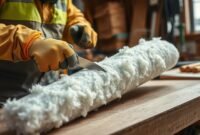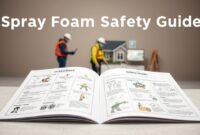Fiberglass insulation, including fiberglass batts, is a common choice for insulating homes, but many people wonder whether it’s flammable or fire-resistant. It’s important to understand that fiberglass insulation, made from tiny glass fibers, is naturally fire-resistant.
This makes it a safe insulation solution for areas prone to fire hazards, such as near electrical outlets or existing walls.
It is a woven product crafted from plastic reinforced with tiny glass fibers with resin and binding substances added to the mixture to enhance its strength and durability. This combination results in a material that is widely used for insulating homes.
To help you learn more, we will explore fiberglass insulation’s properties, ability to withstand high temperatures and safety considerations.
Does Fiberglass Insulation Burn? At What Temperature Does It Burn?
Fiberglass insulation, particularly in the form of batts, is known for its fire-resistant properties. In practical terms, fiberglass is nonflammable and does not catch fire, making it a reliable choice for attic insulation and other areas where fire safety is a concern.

It cannot burn because it is predominantly made from glass. However, it does have a point at which it can melt when exposed to high temperatures, and the temperature at which fiberglass begins to soften and melt is relatively high.
What Temperature Does Fiberglass Melt?
Fiberglass, including loose-fill fiberglass, can withstand temperatures of up to 1000°F (537.8°C) before it softens. This temperature is significantly above what you typically encounter in a household fire, making it a safe and effective insulation solution for existing walls and other areas of a home.
To put this in perspective, a household fire generally does not reach temperatures as high as 1000°F, making it unlikely that fiberglass insulation in your walls or attic would ignite.
This characteristic makes fiberglass, especially when safely installed, a safe choice in wood-framed buildings as a fire block and for condensation control.
Read also: Comparison Between Fiberglass VS Cellulose Blown Insulation
Is Fiberglass Insulation Safe?
While fiberglass insulation, including cellulose insulation, is fire-resistant, it is essential to be aware of other potential hazards associated with this material. These include skin irritation, eye irritation, breathing problems, and cancer risks.
However, when safely installed and handled correctly, fiberglass remains a popular and effective insulation solution for homes.
Read also: Rockwool Insulation vs Fiberglass
● Skin Irritation
Fiberglass is made from glass fibers, and these fibers can be sharp. When you come into contact with fiberglass insulation without proper protection, you risk embedding tiny glass shards in your skin. It can lead to itching and irritation, sometimes mistaken for a skin rash.
● Eye Irritation
Fiberglass particles that contact your eyes can cause redness, irritation, and swelling. Therefore, wearing protective eyewear when handling fiberglass insulation is crucial to prevent this.
● Breathing Problems
Fiberglass particles are lightweight and can be easily inhaled. When these tiny glass fibers enter the human body, they can potentially cut and penetrate organs and tissues. Common signs of fiberglass inhalation include a sore or irritated throat, painful nasal passages, sore lungs, and difficulty breathing.
Suppose you have pre-existing respiratory conditions like asthma or bronchitis. In that case, fiberglass exposure can worsen your symptoms or even trigger a respiratory emergency. Additionally, ingesting its particles can lead to severe stomach pain and irritation.
● Cancer Risks
Fiberglass is considered a suspected carcinogen. Some studies have shown increased cancer risk in mice when exposed to fiberglass in lung tissue. However, the potential cancer risk in humans remains a topic of ongoing research and debate.
Nowadays, most modern fiberglass insulation products are no longer manufactured with carcinogenic chemicals, so some people say there are no cancer risks anymore.
Read also: How Long Does Fiberglass Insulation Last
However, it’s important to note that these health hazards are primarily relevant when dealing with direct contact and exposure only. Once fiberglass insulation is installed in your home, its risks are significantly reduced. But to minimize the exposure, here’s what you can do:
- Wear loose-fitting clothing to reduce skin contact.
- Use gloves to protect your hands.
- Wear a mask that covers your nose and mouth.
- Employ safety goggles with side shields to safeguard your eyes.
- Ensure proper ventilation by opening doors and windows.
- Use a shop vacuum designed for wet dust and fibers to clean up effectively.
In conclusion, does fiberglass insulation burn? No, since it is fire-resistant and can withstand high temperatures, making it a safe choice for insulating homes. However, taking precautions when handling fiberglass is essential to minimize other potential hazards.


